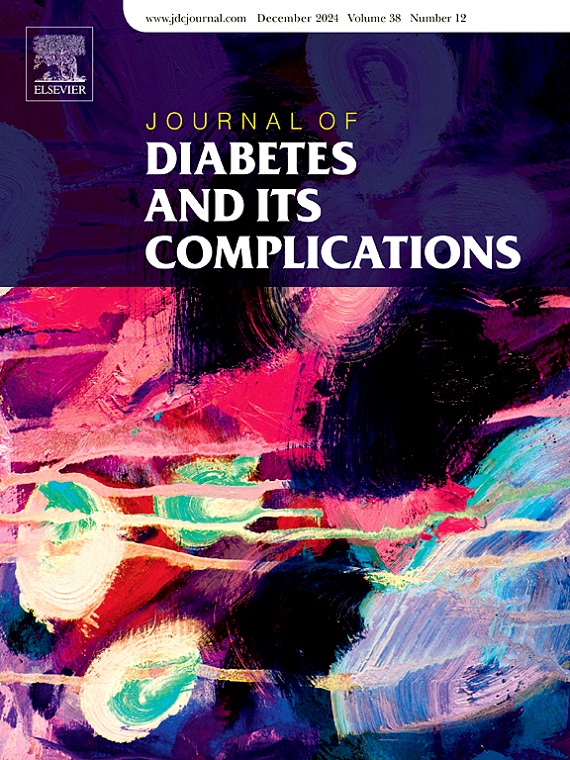美国中老年人群的糖尿病、焦虑和死亡风险
IF 3.1
3区 医学
Q3 ENDOCRINOLOGY & METABOLISM
引用次数: 0
摘要
背景2型糖尿病(T2D)仍然是美国发病率和死亡率的主要原因。此外,在美国,焦虑是最常见的心理健康问题之一。虽然T2D患者的焦虑负担是众所周知的,但焦虑对成人T2D患者的长期影响尚未得到很好的探讨。因此,这项全国性研究的目的是确定焦虑对美国T2D患者死亡率的影响。方法将美国国家健康与营养检查调查(2007-2012年)的数据与截至2019年12月31日的国家死亡指数的死亡率数据相关联。结果共有14137名成年人(50岁及以上)被纳入研究样本,其中超过十分之一(12.8%)患有T2D,超过五分之一(22.6%)患有焦虑症。T2D患者与非T2D患者相比,未调整的全因死亡风险风险比(HR)为2.08(95%可信区间[CI], 1.83-2.35, p < 0.01)。在调整后的分析中,与单纯焦虑或T2D患者相比,同时患有焦虑和T2D患者的全因死亡风险最高[AHR = 1.81 (95% CI 1.37-2.40, p < 0.01)]。结论sour分析提供了有助于干预措施降低T2D合并焦虑患者死亡风险的重要信息。此外,考虑到并发T2D和焦虑的死亡率较高,协作医疗实践应该有助于广泛筛查和治疗中老年人2型糖尿病患者的焦虑。本文章由计算机程序翻译,如有差异,请以英文原文为准。
Diabetes, anxiety, and mortality risk among middle and older-aged Americans
Background
Type 2 Diabetes (T2D) continues to be a major cause of morbidity and a leading cause of mortality in the United States. Also, anxiety ranks among the topmost common mental health problems in the U.S. While the burden of anxiety among individuals with T2D is well known, the long-term impact of anxiety among adults with T2D has not been well explored. Thus, the purpose of this national study was to ascertain the impact of anxiety on mortality among Americans with T2D.
Methods
Data from the U.S. National Health and Nutrition Examination Survey (years 2007–2012) were linked with mortality data from the National Death Index up to December 31st, 2019.
Results
A total of 14,137 adults (aged 50 years and older) were included in the study sample, with more than a tenth (12.8 %) having T2D and more than a fifth (22.6 %) having anxiety. The unadjusted hazard ratio (HR) for all-cause mortality risk among those with T2D was 2.08 (95 % confidence interval [CI], 1.83–2.35, p < 0.01) compared to those without T2D. In the adjusted analysis, the risk of all-cause mortality was highest among individuals with both anxiety and T2D [AHR = 1.81 (95 % CI 1.37–2.40, p < 0.01)] compared to those with anxiety or T2D alone.
Conclusions
Our analysis provides vital information on factors that could be helpful for interventions to reduce mortality risk among those with T2D and anxiety. Also, given the higher risk of mortality with co-occurring T2D and anxiety, collaborative healthcare practices should help with widespread screening for and treatment of anxiety among middle and older-age adults with Type 2 Diabetes.
求助全文
通过发布文献求助,成功后即可免费获取论文全文。
去求助
来源期刊

Journal of diabetes and its complications
医学-内分泌学与代谢
CiteScore
5.90
自引率
3.30%
发文量
153
审稿时长
16 days
期刊介绍:
Journal of Diabetes and Its Complications (JDC) is a journal for health care practitioners and researchers, that publishes original research about the pathogenesis, diagnosis and management of diabetes mellitus and its complications. JDC also publishes articles on physiological and molecular aspects of glucose homeostasis.
The primary purpose of JDC is to act as a source of information usable by diabetes practitioners and researchers to increase their knowledge about mechanisms of diabetes and complications development, and promote better management of people with diabetes who are at risk for those complications.
Manuscripts submitted to JDC can report any aspect of basic, translational or clinical research as well as epidemiology. Topics can range broadly from early prediabetes to late-stage complicated diabetes. Topics relevant to basic/translational reports include pancreatic islet dysfunction and insulin resistance, altered adipose tissue function in diabetes, altered neuronal control of glucose homeostasis and mechanisms of drug action. Topics relevant to diabetic complications include diabetic retinopathy, neuropathy and nephropathy; peripheral vascular disease and coronary heart disease; gastrointestinal disorders, renal failure and impotence; and hypertension and hyperlipidemia.
 求助内容:
求助内容: 应助结果提醒方式:
应助结果提醒方式:


